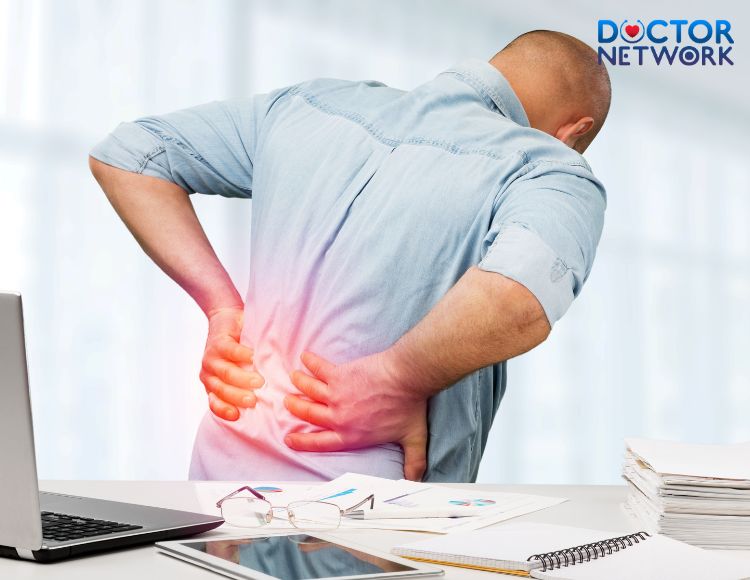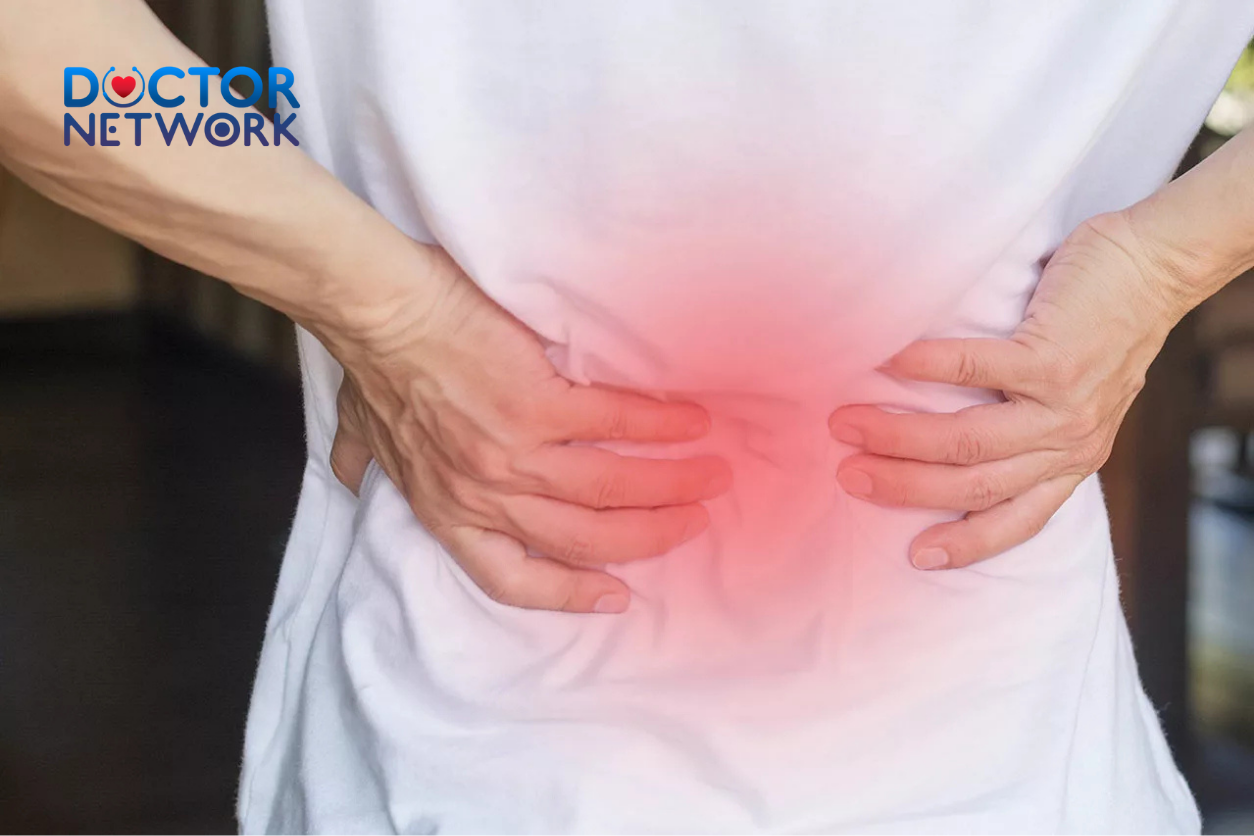Disc herniation is a condition where the intervertebral disc, a soft cushioning layer between the vertebrae, slips out of its normal position. This can occur due to various reasons such as heavy lifting, trauma, or degeneration of the disc due to aging. Let’s explore the question “Is disc herniation treatable?” through the following article.
Symptoms of Disc Herniation
Back pain
is one of the primary symptoms of disc herniation. Pain often occurs in the lower back region, may radiate to both sides, or concentrate on one side. The pain can range from mild to severe and can even impair the patient’s mobility. For some individuals, back pain can become extremely uncomfortable, making it difficult to perform daily activities such as sitting, standing, or lying down.

Back pain is one of the main symptoms of disc herniation
Pain in Arms or Legs
When disc herniation causes compression or damage to the nerves, pain can radiate to other parts of the body such as the arms and legs. Pain in the arms or legs can cause numbness, tingling, or weakness. For some individuals, this pain can decrease mobility and hinder regular activities.
Limitation of Movement and Daily Activities
Symptoms of disc herniation often lead to limitations in movement and the ability to perform daily activities. Patients may struggle with simple movements like bending, twisting, or turning their bodies. The sensation of pain and discomfort can reduce flexibility and the ability to engage in physical activities.
Overall, the symptoms of disc herniation not only cause discomfort but also impact the patient’s mobility and quality of daily life. So, can disc herniation be treated? Early identification and timely treatment are crucial to reducing the impact of the condition and improving the quality of life.
Treatment Methods for Disc Herniation Non-Surgical Methods
Exercise and Movement Therapy: Can disc herniation be treated without surgery? Exercise and movement therapy play a significant role in treating disc herniation without the need for surgery. Appropriate exercises can improve muscle strength, enhance flexibility, and stabilize the spine, reducing pressure on the disc and alleviating pain. Experts often guide patients on suitable exercises based on their specific condition.

Exercise and movement play an important role in treating disc herniation without the need for surgery
Pain Relief and Anti-inflammatory Medications: Can disc herniation be treated without surgery? Using pain relief and anti-inflammatory medications such as Paracetamol, Ibuprofen, or Naproxen can help reduce the pain and inflammation caused by disc herniation. However, medications should be used as directed by a doctor and adhere to the correct dosage.
Functional Rehabilitation Medicine: Can disc herniation be treated without surgery? Functional rehabilitation medicine is an advanced technique aimed at improving movement function and reducing pain for individuals with disc herniation. This often includes methods such as physical therapy, massage, and other techniques to enhance flexibility, muscle strength, and reduce tension.
Surgical Methods
Spinal Surgery: Can disc herniation be treated without surgery? In severe cases or when non-surgical methods are ineffective, spinal surgery may be considered. Surgery may involve removing the damaged disc, relieving pressure on the nerves, or stabilizing the spine for better alignment.
Post-Surgery Recovery and Care: Can disc herniation be treated without surgery? After surgery, the recovery process and care are essential to ensure the success of the procedure. This includes adhering to follow-up appointments, performing rehabilitation exercises under the guidance of experts, and following instructions on post-operative care and spinal protection.
In summary, the treatment methods for disc herniation vary from non-surgical approaches such as exercise and medication to surgical methods such as spinal surgery. The choice between methods depends on the severity of the condition and the overall health status of the patient. Additionally, it is essential to discuss and seek advice from healthcare professionals to make the best decision for each specific case.
Improving Quality of Life for Individuals with Disc Herniation
Reducing Stress and Stress Management
Stress and tension can cause muscle tightness and increase pain sensation in individuals with disc herniation. Therefore, reducing stress and tension can play a crucial role in improving their quality of life. Stress reduction methods such as meditation, yoga, and deep breathing can help alleviate feelings of stress and tension. Additionally, time management and identifying stressors in daily life are important measures to reduce stress.

Stress reduction methods such as meditation and yoga can help reduce feelings of tension and stress
Nutrition and Healthy Lifestyle
A balanced diet and a healthy lifestyle can help improve overall health and reduce symptoms of disc herniation. Maintaining an ideal body weight helps reduce pressure on the spine and discs. Calcium and vitamin D supplementation in the diet can also help enhance bone and spine health. Furthermore, limiting the consumption of stimulants such as caffeine and nicotine can reduce the risk of inflammation and pain.
Prevention of Recurrence
To prevent the recurrence of disc herniation, maintaining a healthy lifestyle and implementing preventive measures are crucial. This includes maintaining an ideal body weight, regular exercise, and avoiding activities that exert excessive pressure on the spine. Additionally, creating comfortable working and resting conditions, as well as maintaining proper posture while sitting, standing, and lying down are important measures to reduce the risk of recurrence.
In summary, applying stress reduction measures, maintaining a healthy diet, and implementing preventive measures are crucial in improving the quality of life for individuals with disc herniation. Additionally, maintaining compliance and patience in the treatment and prevention process are essential for achieving the best outcomes.
Scientific Evidence on the “Is disc herniation treatable”
Here are some scientific references regarding the treatability of disc herniation:
- A study published in “The New England Journal of Medicine” showed that 90% of disc herniation patients could improve symptoms after 6 months of conservative treatment methods, including physical therapy, pain medications, and steroid injections.
- A study published in “Spine” indicated that surgery could improve symptoms in 80% of severe disc herniation patients.
- A study published in “The Journal of Bone and Joint Surgery” demonstrated that exercise could improve function and reduce pain in disc herniation patients.
In the treatment of disc herniation, non-surgical methods such as exercise, pain medication, and functional rehabilitation medicine are often preferred and can positively impact symptom reduction and improve the quality of life for patients. However, in severe cases or when non-surgical methods are ineffective, spinal surgery may be a viable option. We hope the question “Is disc herniation treatable?” has been thoroughly addressed through the article.
References:
https://my.clevelandclinic.org/health/diseases/12768-herniated-disk
https://www.health.harvard.edu/pain/will-my-herniated-disc-heal-on-its-own
https://www.spine-health.com/blog/can-herniated-discs-heal-their-own
Kiểm Duyệt Nội Dung
More than 10 years of marketing communications experience in the medical and health field.
Successfully deployed marketing communication activities, content development and social networking channels for hospital partners, clinics, doctors and medical professionals across the country.
More than 6 years of experience in organizing and producing leading prestigious medical programs in Vietnam, in collaboration with Ho Chi Minh City Television (HTV). Typical programs include Nhật Ký Blouse Trắng, Bác Sĩ Nói Gì, Alo Bác Sĩ Nghe, Nhật Ký Hạnh Phúc, Vui Khỏe Cùng Con, Bác Sỹ Mẹ, v.v.
Comprehensive cooperation with hundreds of hospitals and clinics, thousands of doctors and medical experts to join hands in building a medical content and service platform on the Doctor Network application.

























